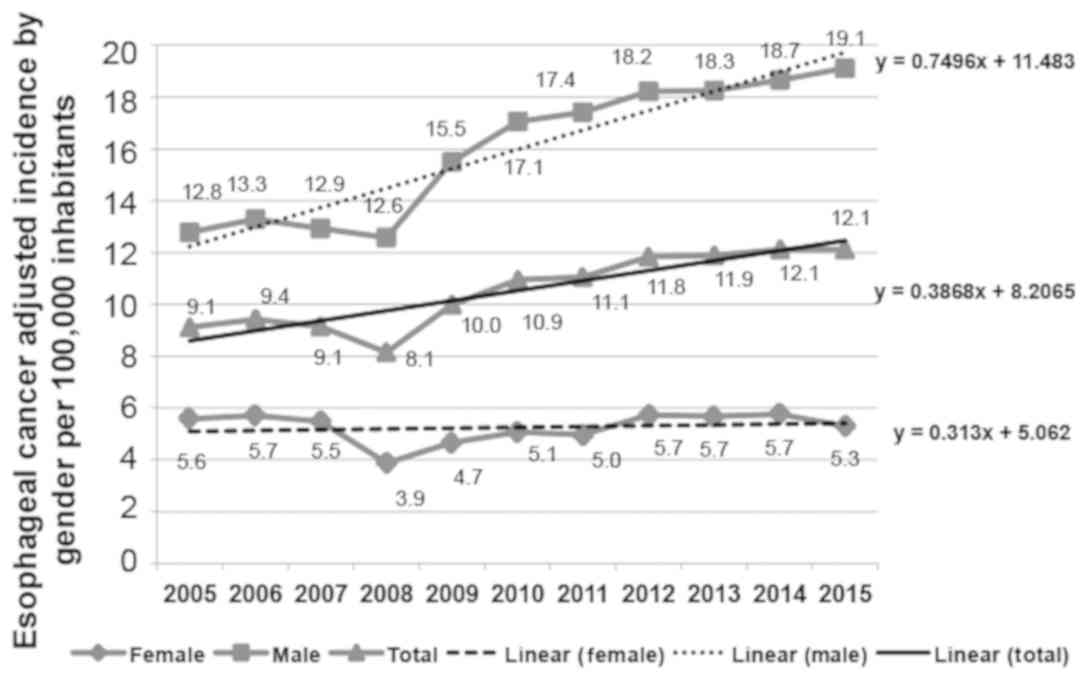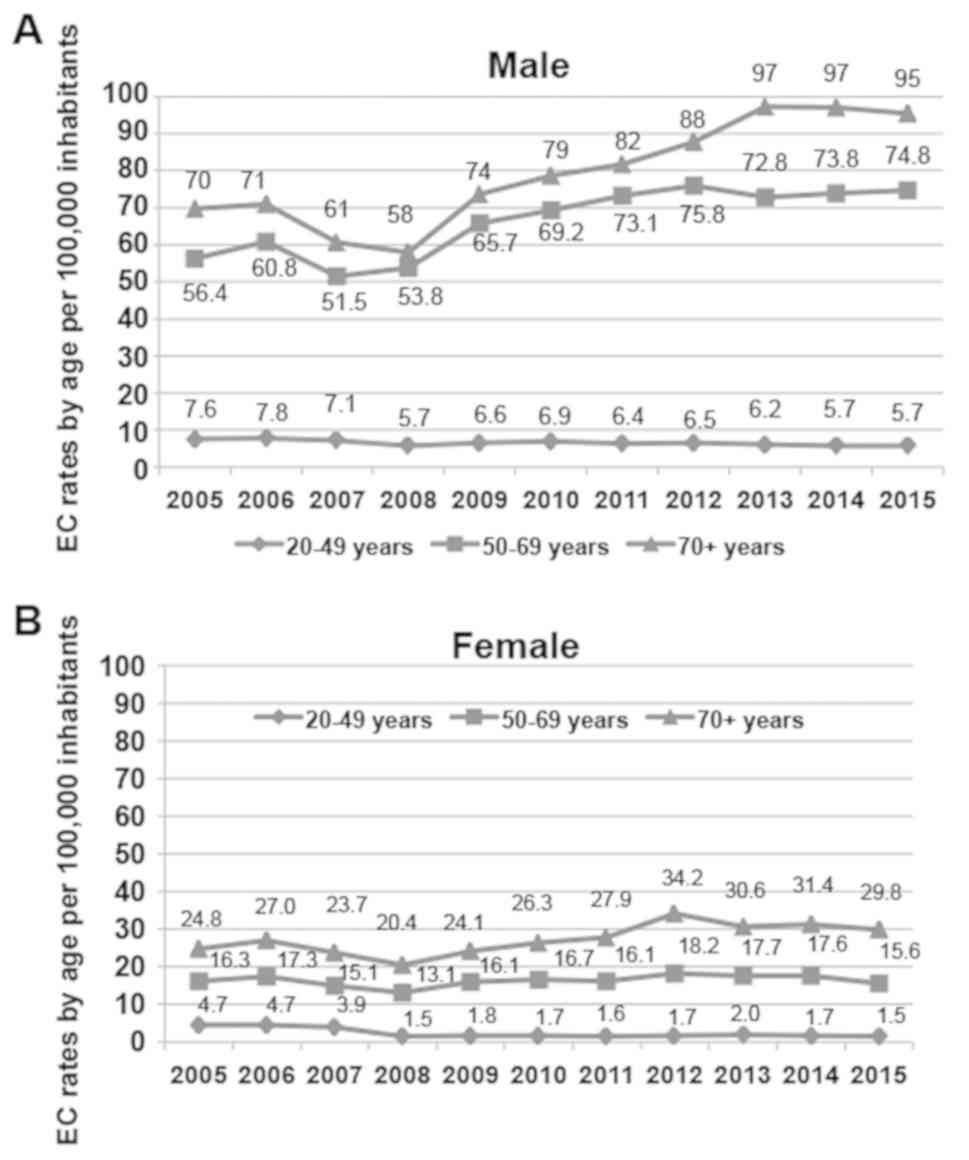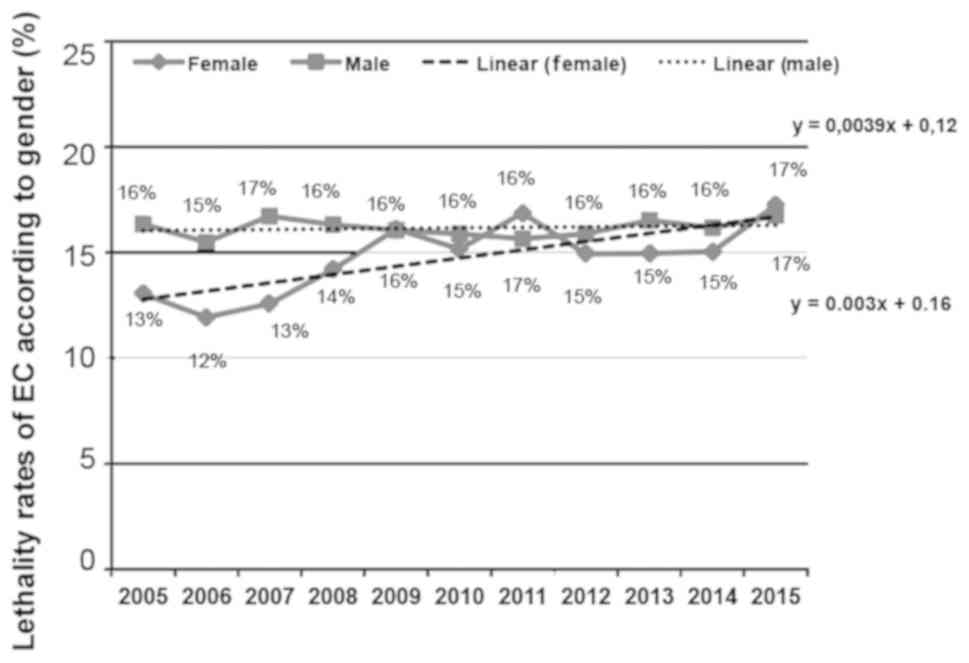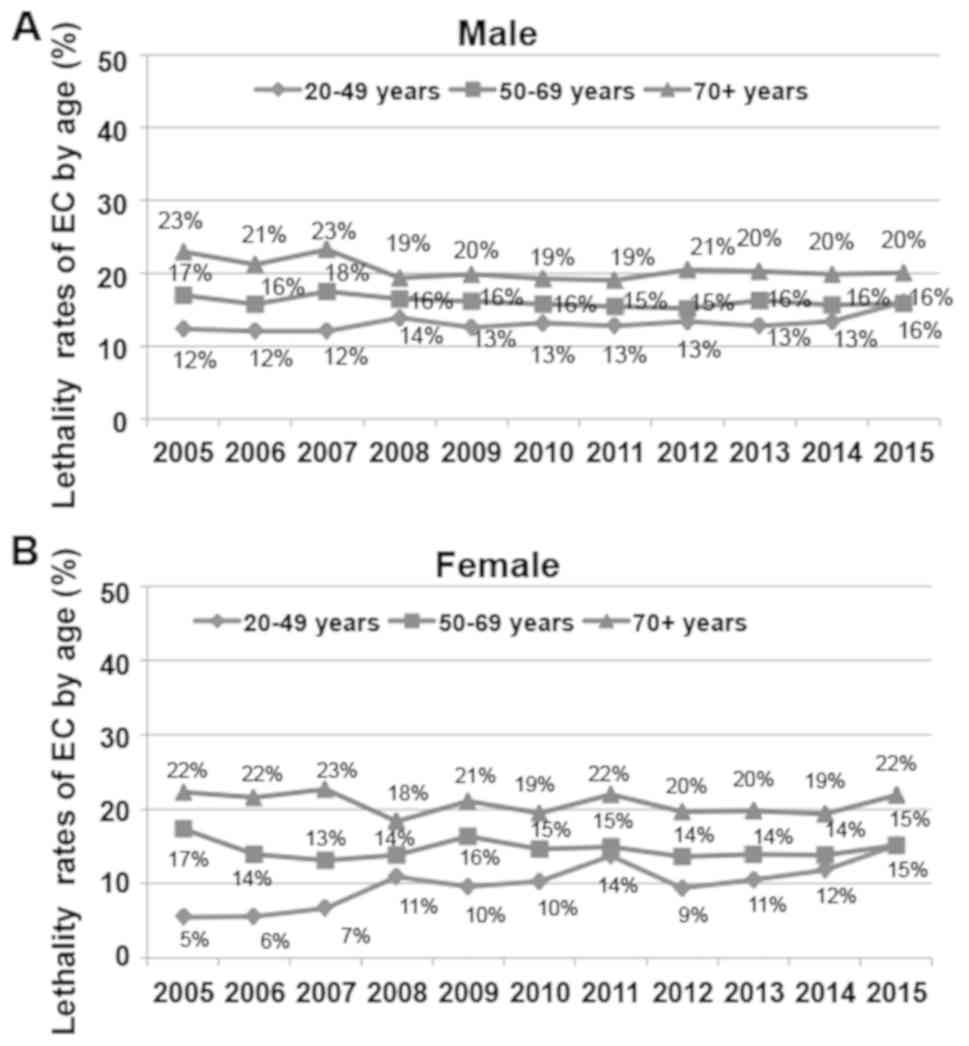|
1
|
Jemal A, Bray F, Center MM, Ferlay J, Ward
E and Forman D: Global cancer statistics. CA Cancer J Clin.
61:69–90. 2011. View Article : Google Scholar : PubMed/NCBI
|
|
2
|
Pennathur A, Gibson MK, Jobe BA and
Luketich JD: Oesophageal carcinoma. Lancet. 381:400–412. 2013.
View Article : Google Scholar : PubMed/NCBI
|
|
3
|
Mao WM, Zheng WH and Ling ZQ:
Epidemiologic risk factors for esophageal cancer development. Asian
Pac J Cancer Prev. 12:2461–2466. 2011.PubMed/NCBI
|
|
4
|
Enzinger PC and Mayer RJ: Esophageal
cancer. N Engl J Med. 349:2241–2252. 2003. View Article : Google Scholar : PubMed/NCBI
|
|
5
|
Domper Arnal MJ, Ferrandez Arenas A and
Lanas Arbeloa A: Esophageal cancer: Risk factors, screening and
endoscopic treatment in western and eastern countries. World J
Gastroenterol. 21:7933–7943. 2015. View Article : Google Scholar : PubMed/NCBI
|
|
6
|
Wheeler JB and Reed CE: Epidemiology of
esophageal cancer. Surg Clin North Am. 92:1077–1087. 2012.
View Article : Google Scholar : PubMed/NCBI
|
|
7
|
Oze I, Matsuo K, Ito H, Wakai K, Nagata C,
Mizoue T, Tanaka K, Tsuji I, Tamakoshi A, Sasazuki S, et al:
Cigarette smoking and esophageal cancer risk: An evaluation based
on a systematic review of epidemiologic evidence among the Japanese
population. Jpn J Clin Oncol. 42:63–73. 2012. View Article : Google Scholar : PubMed/NCBI
|
|
8
|
Yousef F, Cardwell C, Cantwell MM, Galway
K, Johnston BT and Murray L: The incidence of esophageal cancer and
high-grade dysplasia in Barrett's esophagus: A systematic review
and meta-analysis. Am J Epidemiol. 168:237–249. 2008. View Article : Google Scholar : PubMed/NCBI
|
|
9
|
Bhat S, Coleman HG, Yousef F, Johnston BT,
McManus DT, Gavin AT and Murray LJ: Risk of malignant progression
in Barrett's esophagus patients: Results from a large
population-based study. J Natl Cancer Inst. 103:1049–1057. 2011.
View Article : Google Scholar : PubMed/NCBI
|
|
10
|
Renehan AG, Tyson M, Egger M, Heller RF
and Zwahlen M: Body-mass index and incidence of cancer: A
systematic review and meta-analysis of prospective observational
studies. Lancet. 371:569–578. 2008. View Article : Google Scholar : PubMed/NCBI
|
|
11
|
Hoyo C, Cook MB, Kamangar F, Freedman ND,
Whiteman DC, Bernstein L, Brown LM, Risch HA, Ye W, Sharp L, et al:
Body mass index in relation to oesophageal and oesophagogastric
junction adenocarcinomas: A pooled analysis from the International
BEACON Consortium. Int J Epidemiol. 41:1706–1718. 2012. View Article : Google Scholar : PubMed/NCBI
|
|
12
|
Reed PI and Johnston BJ: The changing
incidence of oesophageal cancer. Endoscopy. 25:606–608. 1993.
View Article : Google Scholar : PubMed/NCBI
|
|
13
|
Tran GD, Sun XD, Abnet CC, Fan JH, Dawsey
SM, Dong ZW, Mark SD, Qiao YL and Taylor PR: Prospective study of
risk factors for esophageal and gastric cancers in the linxian
general population trial cohort in China. Int J Cancer.
113:456–463. 2005. View Article : Google Scholar : PubMed/NCBI
|
|
14
|
Munoz N, Crespi M, Grassi A, Qing WG,
Qiong S and Cai LZ: Precursor lesions of oesophageal cancer in
high-risk populations in Iran and china. Lancet. 1:876–879. 1982.
View Article : Google Scholar : PubMed/NCBI
|
|
15
|
Kaz AM and Grady WM: Epigenetic biomarkers
in esophageal cancer. Cancer Lett. 342:193–199. 2014. View Article : Google Scholar : PubMed/NCBI
|
|
16
|
Das M, Saikia BJ, Sharma SK, Sekhon GS,
Mahanta J and Phukan RK: p16 hypermethylation: A biomarker for
increased esophageal cancer susceptibility in high incidence region
of North East India. Tumour Biol. 36:1627–1642. 2015. View Article : Google Scholar : PubMed/NCBI
|
|
17
|
Lepage C, Rachet B, Jooste V, Faivre J and
Coleman MP: Continuing rapid increase in esophageal adenocarcinoma
in England and Wales. Am J Gastroenterol. 103:2694–2699. 2008.
View Article : Google Scholar : PubMed/NCBI
|
|
18
|
Amorim CA, Moreira JP, Rial L, Carneiro
AJ, Fogaça HS, Elia C, Luiz RR and de Souza HS: Ecological study of
gastric cancer in Brazil: Geographic and time trend analysis. World
J Gastroenterol. 20:5036–5044. 2014. View Article : Google Scholar : PubMed/NCBI
|
|
19
|
Perrotta de Souza LM, Moreira JPL, Fogaca
HS, Luiz RR and de Souza HS: Pancreatic cancer incidence and
lethality rates in Brazil: An ecological study. Pancreas.
46:699–706. 2017. View Article : Google Scholar : PubMed/NCBI
|
|
20
|
Veiga JE: The rural dimension of Brasil.
Estud Soc Agric. 12:71–94. 2004.
|
|
21
|
Lepage C, Drouillard A, Jouve JL and
Faivre J: Epidemiology and risk factors for oesophageal
adenocarcinoma. Dig Liver Dis. 45:625–629. 2013. View Article : Google Scholar : PubMed/NCBI
|
|
22
|
Thrift AP and Whiteman DC: The incidence
of esophageal adenocarcinoma continues to rise: Analysis of period
and birth cohort effects on recent trends. Ann Oncol. 23:3155–3162.
2012. View Article : Google Scholar : PubMed/NCBI
|
|
23
|
Mathieu LN, Kanarek NF, Tsai HL, Rudin CM
and Brock MV: Age and sex differences in the incidence of
esophageal adenocarcinoma: Results from the surveillance,
epidemiology, and end results (SEER) registry (1973–2008). Dis
Esophagus. 27:757–763. 2014. View Article : Google Scholar : PubMed/NCBI
|
|
24
|
Lindblad M, Ye W, Lindgren A and Lagergren
J: Disparities in the classification of esophageal and cardia
adenocarcinomas and their influence on reported incidence rates.
Ann Surg. 243:479–485. 2006. View Article : Google Scholar : PubMed/NCBI
|
|
25
|
Whiteman DC, Sadeghi S, Pandeya N,
Smithers BM, Gotley DC, Bain CJ, Webb PM and Green AC; Australian
Cancer Study, : Combined effects of obesity, acid reflux and
smoking on the risk of adenocarcinomas of the oesophagus. Gut.
57:173–180. 2008. View Article : Google Scholar : PubMed/NCBI
|
|
26
|
Souza L, Brunken GS, Segri NJ and Malta
DC: Trends of self-rated health in relation to overweight in the
adult population in Brazilian midwest capitals. Rev Bras Epidemiol.
20:299–309. 2017. View Article : Google Scholar : PubMed/NCBI
|
|
27
|
Kroep S, Lansdorp-Vogelaar I, Rubenstein
JH, Lemmens VE, van Heijningen EB, Aragonés N, van Ballegooijen M
and Inadomi JM: Comparing trends in esophageal adenocarcinoma
incidence and lifestyle factors between the united states, Spain,
and the Netherlands. Am J Gastroenterol. 109:336–343; quiz 335,
344. 2014. View Article : Google Scholar : PubMed/NCBI
|
|
28
|
Sukocheva OA, Li B, Due SL, Hussey DJ and
Watson DI: Androgens and esophageal cancer: What do we know? World
J Gastroenterol. 21:6146–6156. 2015. View Article : Google Scholar : PubMed/NCBI
|
|
29
|
Lagergren K, Lagergren J and Brusselaers
N: Hormone replacement therapy and oral contraceptives and risk of
oesophageal adenocarcinoma: A systematic review and meta-analysis.
Int J Cancer. 135:2183–2190. 2014. View Article : Google Scholar : PubMed/NCBI
|
|
30
|
Szwarcwald CL, Bastos FI, Barcellos C,
Pina MF and Esteves MA: Health conditions and residential
concentration of poverty: A study in Rio de Janeiro, Brazil. J
Epidemiol Community Health. 54:530–536. 2000. View Article : Google Scholar : PubMed/NCBI
|
|
31
|
Bortz M, Kano M, Ramroth H, Barcellos C,
Weaver SR, Rothenberg R and Magalhães M: Disaggregating health
inequalities within Rio de Janeiro, Brazil, 2002–2010, by applying
an urban health inequality index. Cad Saude Publica. 31 (Suppl
1):S107–S119. 2015. View Article : Google Scholar
|
|
32
|
United Nations Development Programme, .
Human development indices and indicators: 2018 statistical update.
http://hdr.undp.org/en/content/human-development-indices-indicators-2018-statistical-updateNovember
5–2018
|
|
33
|
United Nations Educational, Scientific,
Cultural Organization, . United Nations Educational SaCO: Institute
for statistics. http://www.unesco.org/new/en/santiago/resources/statistics/November
5–2018
|
|
34
|
Lin CC, Chiang JH, Li CI, Liu CS, Lin WY,
Hsieh TF and Li TC: Cancer risks among patients with type 2
diabetes: A 10-year follow-up study of a nationwide
population-based cohort in Taiwan. BMC cancer. 14:3812014.
View Article : Google Scholar : PubMed/NCBI
|
|
35
|
Pinto FG and Curi PR: Mortality due to
neoplasms in Brazil (1980/1983/1985): Grouping by states, behavior
and trends. Rev Saude Publica. 25:276–281. 1991.(In Portuguese).
View Article : Google Scholar : PubMed/NCBI
|
|
36
|
Instituto Brasileiro de Geografia e
Estatistica (IBGE), . Health statistics: Survey of medical-sanitary
assistance 2009. https://ww2.ibge.gov.br/english/estatistica/populacao/condicaodevida/ams/2009/default.shtmNovember
5–2018
|
|
37
|
Zhang Y: Epidemiology of esophageal
cancer. World J Gastroenterol. 19:5598–5606. 2013. View Article : Google Scholar : PubMed/NCBI
|
|
38
|
Muwonge R, Ramadas K, Sankila R, Thara S,
Thomas G, Vinoda J and Sankaranarayanan R: Role of tobacco smoking,
chewing and alcohol drinking in the risk of oral cancer in
Trivandrum, India: A nested case-control design using incident
cancer cases. Oral Oncol. 44:446–454. 2008. View Article : Google Scholar : PubMed/NCBI
|
|
39
|
Paim J, Travassos C, Almeida C, Bahia L
and Macinko J: The Brazilian health system: History, advances, and
challenges. Lancet. 377:1778–1797. 2011. View Article : Google Scholar : PubMed/NCBI
|
|
40
|
Beard JR and Bloom DE: Towards a
comprehensive public health response to population ageing. Lancet.
385:658–661. 2015. View Article : Google Scholar : PubMed/NCBI
|
|
41
|
Malta DC, Stopa SR, Santos MAS, Andrade
SSCA, Oliveira TP, Cristo EB and Silva MMAD: Evolution of tobacco
use indicators according to telephone surveys, 2006–2014. Cad Saude
Publica. 33 (Suppl 3):e001349152017.(In English, Portuguese).
|
|
42
|
Azevedo e Silva G, Valente JG and Malta
DC: Trends in smoking among the adult population in Brazilian
capitals: A data analysis of telephone surveys from 2006 to 2009.
Rev Bras Epidemiol. 14 (Suppl 1):S103–S114. 2011.(In English,
Portuguese).
|
|
43
|
Moura MA, Bergmann A, Aguiar SS and Thuler
LC: The magnitude of the association between smoking and the risk
of developing cancer in Brazil: A multicenter study. BMJ open.
4:e0037362014. View Article : Google Scholar : PubMed/NCBI
|
|
44
|
Bartholomay P, Iser BP, de Oliveira PP,
dos Santos TE, Malta DC, Sobel J and de Moura L: Epidemiologic
investigation of an occupational illness of tobacco harvesters in
southern Brazil, a worldwide leader in tobacco production. Occup
Environ Med. 69:514–518. 2012. View Article : Google Scholar : PubMed/NCBI
|
|
45
|
Opaleye ES, Sanchez ZM, Moura YG, Galduroz
JC, Locatelli DP and Noto AR: The Brazilian smoker: A survey in the
largest cities of Brazil. Braz J Psychiatry. 34:43–51. 2012.
View Article : Google Scholar : PubMed/NCBI
|
|
46
|
Fiori NS, Faria NM, Meucci RD and Fassa
AG: Smoking prevalence and associated factors among tobacco farmers
in southern Brazil. Cad Saude Publica. 32:S0102–311X2016000705012.
2016.(In Portuguese). PubMed/NCBI
|
|
47
|
Munhoz TN, Santos IS, Nunes BP, Mola CL,
Silva I and Matijasevich A: Trends in alcohol abuse in Brazilian
state capitals from 2006 to 2013: An analysis of data from the
VIGITEL survey. Cad Saude Publica. 33:e001045162017.(In
Portuguese). PubMed/NCBI
|
|
48
|
Munoz N, Victora CG, Crespi M, Saul C,
Braga NM and Correa P: Hot mate drinking and precancerous lesions
of the oesophagus: An endoscopic survey in Southern Brazil. Int J
Cancer. 39:708–709. 1987. View Article : Google Scholar : PubMed/NCBI
|
|
49
|
Szymanska K, Matos E, Hung RJ,
Wünsch-Filho V, Eluf-Neto J, Menezes A, Daudt AW, Brennan P and
Boffetta P: Drinking of mate and the risk of cancers of the upper
aerodigestive tract in Latin America: A case-control study. Cancer
Causes Control. 21:1799–1806. 2010. View Article : Google Scholar : PubMed/NCBI
|
|
50
|
Mello FW, Scotti FM, Melo G,
Warnakulasuriya S, Guerra ENS and Rivero ERC: Mate consumption
association with upper aerodigestive tract cancers: A systematic
review and meta-analysis. Oral Oncol. 82:37–47. 2018. View Article : Google Scholar : PubMed/NCBI
|
|
51
|
Putz A, Hartmann AA, Fontes PR, Alexandre
CO, Silveira DA, Klug SJ and Rabes HM: TP53 mutation pattern of
esophageal squamous cell carcinomas in a high risk area (Southern
Brazil): Role of life style factors. Int J Cancer. 98:99–105. 2002.
View Article : Google Scholar : PubMed/NCBI
|
|
52
|
Castellsague X, Munoz N, De Stefani E,
Victora CG, Castelletto R and Rolon PA: Influence of mate drinking,
hot beverages and diet on esophageal cancer risk in South America.
Int J Cancer. 88:658–664. 2000. View Article : Google Scholar : PubMed/NCBI
|
|
53
|
Wunsch-Filho V: The epidemiology of oral
and pharynx cancer in Brazil. Oral Oncol. 38:737–746. 2002.
View Article : Google Scholar : PubMed/NCBI
|
|
54
|
Sans M: Admixture studies in Latin
America: From the 20th to the 21st century. Hum Biol. 72:155–177.
2000.PubMed/NCBI
|
|
55
|
Lins TC, Vieira RG, Abreu BS, Grattapaglia
D and Pereira RW: Genetic composition of Brazilian population
samples based on a set of twenty-eight ancestry informative SNPs.
Am J Hum Biol. 22:187–192. 2010.PubMed/NCBI
|
|
56
|
Saloum de Neves Manta F, Pereira R, Vianna
R, Rodolfo Beuttenmüller de Araújo A, Leite Góes Gitaí D, Aparecida
da Silva D, de Vargas Wolfgramm E, da Mota Pontes I, Ivan Aguiar J,
Ozório Moraes M, et al: Revisiting the genetic ancestry of
Brazilians using autosomal AIM-Indels. PLoS One. 8:e751452013.
View Article : Google Scholar : PubMed/NCBI
|
|
57
|
Pena SD, Di Pietro G, Fuchshuber-Moraes M,
Genro JP, Hutz MH, Kehdy Fde S, Kohlrausch F, Magno LA, Montenegro
RC, Moraes MO, et al: The genomic ancestry of individuals from
different geographical regions of Brazil is more uniform than
expected. PLoS One. 6:e170632011. View Article : Google Scholar : PubMed/NCBI
|
|
58
|
Daly JM, Fry WA, Little AG, Winchester DP,
McKee RF, Stewart AK and Fremgen AM: Esophageal cancer: Results of
an American college of surgeons patient care evaluation study. J Am
Coll Surg. 190:562–573. 2000. View Article : Google Scholar : PubMed/NCBI
|
|
59
|
Dhillon PK, Farrow DC, Vaughan TL, Chow
WH, Risch HA, Gammon MD, Mayne ST, Stanford JL, Schoenberg JB,
Ahsan H, et al: Family history of cancer and risk of esophageal and
gastric cancers in the United States. Int J Cancer. 93:148–152.
2001. View Article : Google Scholar : PubMed/NCBI
|
|
60
|
Tustumi F, Takeda FR, Kimura CM, Sallum
RA, Ribeiro UJ and Cecconello I: Esophageal carcinoma: Is squamous
cell carcinoma different disease compared to adenocarcinoma? a
transversal study in a quaternary high volume hospital in Brazil.
Arq Gastroenterol. 53:44–48. 2016. View Article : Google Scholar : PubMed/NCBI
|
|
61
|
Eslick GD: Epidemiology of esophageal
cancer. Gastroenterol Clin North Am. 3817–25. (vii)2009. View Article : Google Scholar : PubMed/NCBI
|
|
62
|
Napier KJ, Scheerer M and Misra S:
Esophageal cancer: A Review of epidemiology, pathogenesis, staging
workup and treatment modalities. World J Gastrointest Oncol.
6:112–120. 2014. View Article : Google Scholar : PubMed/NCBI
|
|
63
|
Bosetti C, Levi F, Ferlay J, Garavello W,
Lucchini F, Bertuccio P, Negri E and La Vecchia C: Trends in
oesophageal cancer incidence and mortality in Europe. Int J Cancer.
122:1118–1129. 2008. View Article : Google Scholar : PubMed/NCBI
|
|
64
|
Jemal A, Center MM, DeSantis C and Ward
EM: Global patterns of cancer incidence and mortality rates and
trends. Cancer Epidemiol Biomarkers Prev. 19:1893–1907. 2010.
View Article : Google Scholar : PubMed/NCBI
|
|
65
|
Dikken JL, Dassen AE, Lemmens VE, Putter
H, Krijnen P, van der Geest L, Bosscha K, Verheij M, van de Velde
CJ and Wouters MW: Effect of hospital volume on postoperative
mortality and survival after oesophageal and gastric cancer surgery
in the Netherlands between 1989 and 2009. Eur J Cancer.
48:1004–1013. 2012. View Article : Google Scholar : PubMed/NCBI
|
|
66
|
Dikken JL, Lemmens VE, Wouters MW,
Wijnhoven BP, Siersema PD, Nieuwenhuijzen GA, van Sandick JW, Cats
A, Verheij M, Coebergh JW and van de Velde CJ: Increased incidence
and survival for oesophageal cancer but not for gastric cardia
cancer in the Netherlands. Eur J Cancer. 48:1624–1632. 2012.
View Article : Google Scholar : PubMed/NCBI
|













